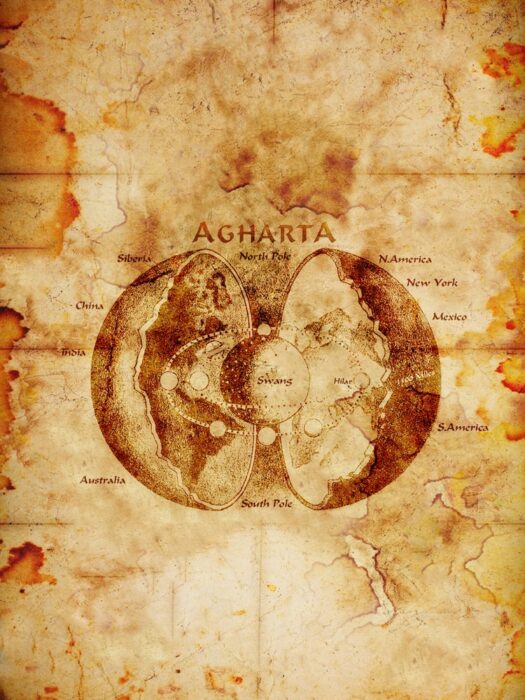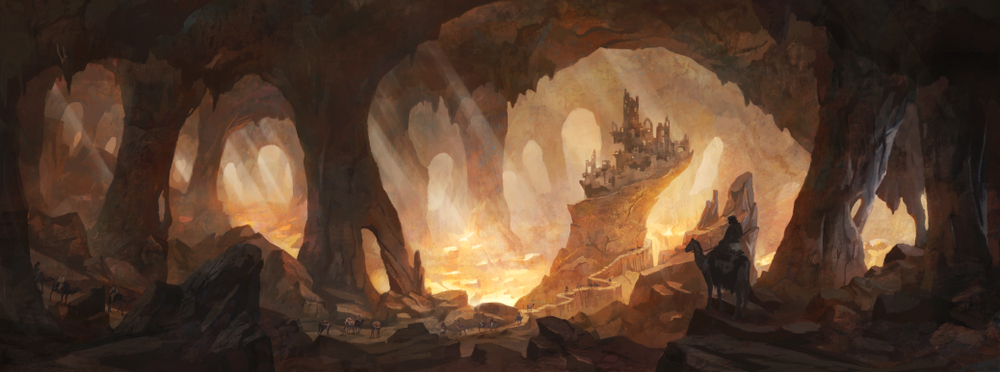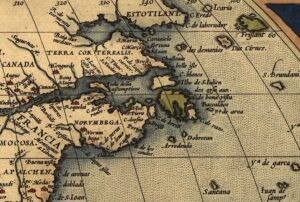We know the Earth is not hollow. While we enjoy the occasional escapism from Jules Verne and Warner Bros., there is nothing beneath our feet but kilometers upon kilometers of lava, rock, gas, high pressures, and the all-powerful forces of our planet.
However, this has not stopped a rather stubborn theory from persisting even today. That is Agartha and the Hollow Earth.
Background
Agartha is a mythical kingdom supposedly located in the center of the Earth. Its entrance lies somewhere deep in the Himalaya. Nepalese outfitters would make a fortune guiding tours there, but so far, none have attempted to open up this market. Yet the subterranean kingdom links all the continents on Earth through an incredible network of tunnels, created by a race of powerful beings called the Old Ones. They far surpass humans physically and spiritually, as well as in intelligence and technology.
Accounts describe this mysterious race as almost omniscient, aware of all happenings on the surface. Supposedly, all world governments know of this city already. Agartha holds millions of people and is ruled by its king, the Master.

Vintage map of Agartha. Photo: M3Pics/Shutterstock
The kingdom preserves its knowledge in vast libraries and has advanced transportation capabilities such as flying vehicles.
Agartha once thrived on the surface. However, as the world became more violent and unstable, the kingdom went underground. According to legend, it will rise again when the world restores balance and peace.
Hollow Earth theory
Because of the similarities, Agartha and the Hollow Earth theory are very closely linked. Hollow Earth, of course, refers to Earth having a hollow center rather than a molten core.
Hollow Earth legends have existed since ancient times and somehow survive even today. It sees the world in layers, with an underworld realm for souls or deities. Dante portrayed the planet this way in his Inferno in the 14th century. Scholars from the 16th century onward thought the Earth had a hollow shell with layers containing different atmospheres, densities, and even a miniature sun at its center.
Accounts of Agartha
All of this sounds familiar, doesn’t it? We’ve all heard it before; Shambhala, Xibalba, Eden, Asgard, etc. Multiple cultures from Hindus, Buddhists, Native American tribes, Celts, and others all convey a similar story of human origins, mythical races, or even gods living in deep caves away from the world.
Perhaps Agartha’s closest relative is Shambhala, with which it is often confused. Shambhala features prominently in sacred Hindu texts. However, the two are not the same. Agartha does not have such ancient backing. The name started to creep onto the scene when French occultist and linguistics enthusiast Alexandre Saint-Yves d’Alveydre took an interest in learning Sanskrit in the 19th century.
He came into contact with a mysterious bloke named Prince Hardjii Scharipf, whose backstory is murky. Nevertheless, he was a very educated man with knowledge of the unknown. This enigmatic tutor came from a supposed “Great Agarthian School.” He learned not only Sanskrit but also an unknown language called Vittanian, apparently spoken by Agarthians. He also learned that Agarthians had two tongues and could speak more than one language at the same time.

Representation of Hollow Earth in The Goddess of Atvatabar by William R. Bradshaw. Photo: William R. Bradshaw
Atlantis connection
Some 19th-century writers believe that subsurface kingdoms might have been a refuge for survivors from Atlantis.
One unexpected development in this story is the internet’s belief that explorer Admiral Richard Byrd came into contact with the Agarthians during a mission in Antarctica. PDFs of his “secret diary” (origins unknown) have been circulating for the last few years, which allegedly recorded his encounters in early 1947. Byrd was in Antarctica at this time for Operation Highjump, the establishment of an American research base.
While flying over the frigid landscape, Byrd’s instruments went haywire and he saw a green forest among the snowy mountain ranges. His radio was then highjacked by the Agarthian superbeings. They invited him to land and visit the subterranean city. He described it as “a vast metropolis, glittering with rainbow colors…too beautiful and wondrous to describe…[and] formed of a crystal-like substance.”

Richard Byrd’s exploits, some real, others not so real, made him a celebrity in the 1920s.
Admiral Byrd
In exploration history, Byrd is known for two things: faking a flight to the North Pole — which, like Robert Peary’s 1909 North Pole expedition, the public believed was successful until recent decades — and overwintering alone in Antarctica, where he almost died from carbon monoxide poisoning from a leaky stove. However, Byrd said nothing about Agarthians, nor did he spot some nonexistent Antarctic oasis. That’s all online disinformation.
These Agarthians supposedly expressed their concern to him over the World Wars as well as the current development of nuclear weapons. After their meeting, they sent Byrd back to the surface and he was sworn to secrecy by the U.S. government after reporting what he saw to the Pentagon. It is quite a story, one which Raymond Bernard (a pseudonym), the main driver of the Hollow Earth theory, wrote about in the 1960s.
In addition, it was no secret that the Nazis had a morbid fascination with the occult. According to conspiracy theories, after losing World War II, Hitler and his goons fled to the South Pole and hid in the center of the Earth. Some even believe that the Chinese invaded Tibet in the 1950s to gain access to this mythical kingdom.
Expeditions
There have been a couple of expeditions to find Hollow Earth. President John Quincy Adams approved of one such expedition, according to writer Rachel Baxter of Iflscience. A particularly staunch supporter of the Hollow Earth theory was a man named John Cleves Symmes Jr. He believed the North and South Poles had two large holes into which you could dive.
The North Pole Inner Earth Expedition in the 2000s attempted to find these mysterious holes. A planned 2022 follow-up expedition has been indefinitely delayed.
Why?
Was Agartha a Western invention? Occultism has contributed to some quite outlandish beliefs about the planet. Take theosophy, for example. Helena Blavatsky’s movement believed in Agartha as one of the subterranean realms inhabited by the “masters of wisdom.” They reputedly came from an island which is “no more, but the country where it once bloomed remains there still…”
Hollow Earth societies run parallel to those of Flat Earth. No one takes them seriously, but the stories are interesting as psychological case studies. Conspiracy theorists and fans of Ancient Aliens get behind these notions as if they were gospel. Online forums, whole societies, and clickbaity YouTube videos dedicated to furthering the theory all agree that Byrd found something he wasn’t supposed to.
Alas, if the Earth were hollow, we would know. Our planet’s mass, density, and gravity would be vastly different. We know this due to surveys, tests with seismic waves, data from boreholes, and other methods. Agartha is one of those many cases where ugly facts stand in the way of a beautiful story.






